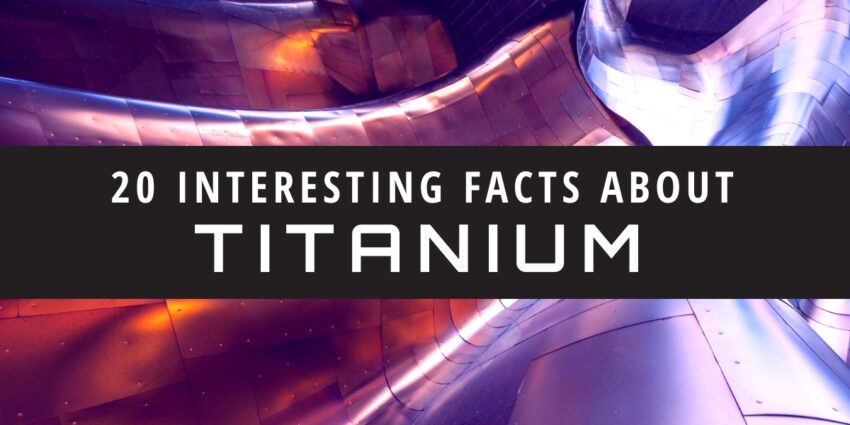Titanium (Ti) is a strong, silver-gray metal that is highly resistant to corrosion and is chemically inert. Unlike most other metals, titanium is not a particularly good conductor of heat or electricity and is not very dense. Titanium is non-magnetic.
Because of the unique physical properties of titanium metal and the whiteness provided by TiO2, titanium is used around the world and has become essential to the smooth functioning of modern industrial economies. Titanium metal is an important strategic, critical material used widely in high-performance military and civilian aircraft in both engines and airframes.
Beyond the basics above, what else should we know about titanium? Check out the 20 interesting facts below!
- Titanium is the ninth most abundant element, making up about 0.6 percent of the Earth’s crust. It occurs in nature only in chemical combination, usually with oxygen and iron; the surface of titanium oxidizes immediately when exposed to air.
- Titanium was first discovered in 1791 by the British clergyman and amateur geologist William Gregor, who produced a white metallic oxide from black magnetic sands.
- The original name for titanium was “manaccanite”.
- In 1795, the German chemist Martin Klaproth independently discovered titanium. He named the oxide “titanium” after the Greek Titans, a mythical race of immortal giants with incredible strength and stamina, but later recognized William Gregor’s earlier discovery.
- It took almost 119 years to get 99.9 percent pure Titanium. It was isolated by Matthew Hunter, a metallurgist in the year 1910 at Rensselaer Polytechnic Institute in Schenectady, New York. He heated Sodium and Titanium Tetrachloride to at 700 to 800o C in extremely high pressure using a process called Batch Process or Hunter Process.
- Hunter’s difficult isolation process made titanium metal mainly a laboratory curiosity until 1938 when William Kroll developed a method (known as the Kroll method) to produce titanium metal in commercial quantities.
- In the 1950s and 1960s, the Soviet Union started using Titanium in aerospace and defense. Titanium became an essential Cold War mineral.
- In May 2018, the U.S. Department of the Interior, in coordination with other executive branch agencies, published a list of 35 critical minerals (83 FR 23295), including titanium. This list was developed to serve as an initial focus, pursuant to Executive Order 13817, ‘‘A Federal Strategy to Ensure Secure and Reliable Supplies of Critical Minerals” (82 FR 60835).
- Only about 5 percent of the world’s annual production of titanium minerals goes to make titanium metal. The other 95 percent of such production is used primarily to make white TiO2 pigment.
- In 2018, an estimated 80 percent of titanium metal was used in aerospace applications; the remaining 20 percent was used in armor, chemical processing, marine hardware, medical implants, power generation, and consumer and other applications.
- In 2018, the estimated end-use distribution of TiO2 pigment consumption was paints (including lacquers and varnishes), 69%; plastics, 25%; paper, 5%; and other, 1%. Other uses of TiO2 included catalysts, ceramics, coated fabrics and textiles, floor coverings, printing ink, and roofing granules.
- Global production of titanium minerals is dominated by Australia, Canada, China, and South Africa. The largest deposits of ilumenite sands and rulite ( from which titanium is derived ) are found in Canada and Australia.
- The United States is heavily dependent on imports of titanium mineral concentrates to meet its domestic needs. U.S. Import Sources (2014–17): South Africa, 35%; Australia, 27%; Canada, 12%; Mozambique, 11%; and other, 15%.
- Titanium is as strong as steel but 45 percent lighter and 30 percent more elastic.
- Titanium is twice as strong as aluminum but only 60 percent heavier.
- Titanium is resistant to salt water, perspiration and acids.
- Titanium has a “low magnetic signature” reducing visibility to metal detectors.
- Most titanium produced is refined into titanium dioxide. Titanium dioxide (TiO2 ) has a very high refractive index, which means that it has high light-scattering ability. As a result, TiO2 imparts whiteness, opacity, and brightness to products such as paint, rubber, paper, plastic, and wallboard.
- Because TiO2 is relatively inert, it can be used as coloring in such products as toothpaste, skim milk, candy, and sunscreen.
- Because of their high strength-to-weight ratio and corrosion resistance, titanium metal and titanium metal alloys have proven to be technically superior in a wide variety of industrial and commercial applications in such fields as aerospace, architecture, sporting equipment, military hardware, watch making, eye wear, medical implants, dental products, consumer goods, and more.
